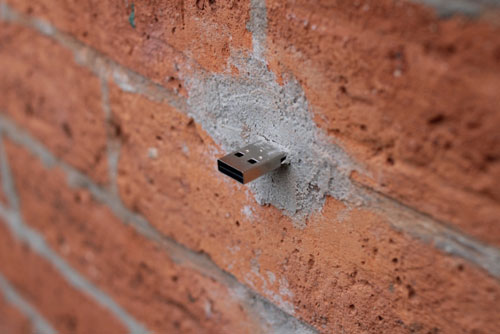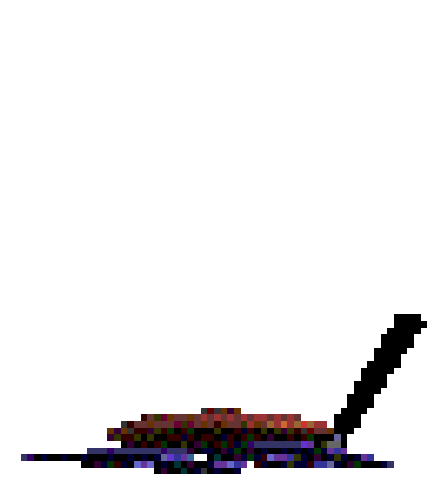
hat tip dump.fm and nutting associates

An image can just be beautiful but it's better if its beautiful and smart. Or even better, smart masquerading as dumb. Brandon Blommaert's animation above (originally from this pop-up exhibition) seduces with a novel combination of organic patterning and sleek geometry; GIFs like this are grist for "art and technology" websites but could also double as high-end corporate design. It has no narrative but simply loops delectably.
The down and dirty remix below by Seamonkey (who found the Blommaert bouncing around Tumblr, per a convo on dump.fm) gives us a story and something to think about. Through the relatively simple intervention of allowing Blommaert's frames to layer and stack rather than disappear from view, Seamonkey transforms an active mesh into a quiescent, banded solid. Where before we had a phrase ("shimmering curvy grid") we now have a sentence ("...turns into a brick"). Blommaert's version rests easily on the eyes, smoothly eliminating traces of itself as it loops; Seamonkey's uses that elegance against itself, cycling repeatedly into an obdurate, less articulated mass. Where the original took pains to hide its own manufacture, the remix confronts us with the mechanics. Let's go out on a limb here and say that the former is design but the latter is art.

Through the addition of contrast and "parts of speech" Seamonkey makes aspects of the original more apparent and palpable. Specifically, the scaly pattern seems more reptilian and the curvy parts more alive for being paired with their inert opposites. (This would be especially noticeable if you encountered the remix by itself on the net and not on the same page with its parent.) One imagines some nanoscale replication of life processes in the laboratory, for example, a slab of vat-grown lizard skin used in the mass production of handbags, or body armor for technologically augmented soldiers being sent into a radioactive zone. Such flights of fancy aren't inspired by the original, which mainly suggests a CAD building being drawn and erased in timelapse. The "algo" [algorithm --ed.] is groovy but without any transition or self-questioning the piece is all algo.
And in case this is getting too serious, there is jello salad.

photo by Aram Bartholl
A while back we were talking about the somewhat aesthetically problematic business strategy of "taking a GIF offline so the collector could have it locally."
Now comes the Street Show, where the collector (i) doesn't pay, (ii) receives no certificate of authenticity, (iii) has the option to hoard or recycle the collected work, (iv) has to jockey with others on the street with USB-equipped gear and ultimately (v) obtains an electronic file that is unique only because the artist serendipitously decided to do a "one-off"--an even worse business model!
Here is the statement for the show, organized by Michael Manning:
Street Show: The Things Between Us is an exhibition of new work from 22 different artists distributed solely through a USB Dead Drop installed at 540 W. 21st St. (@Eyebeam Center for Art + Technology) in New York City. Dead Drops (started by Aram Bartholl) are USB flash drives installed in public locations (buildings, train stations, museums etc) around the world to create an anonymous offline peer-to-peer file-sharing network. For The Things Between Us each artist was asked to make a piece based on the idea of TRANSFER (whatever that meant to them) that would be unique and only available through the Dead Drop.
The Street Show exhibition format is an experiment in the absurd pursuit of creating scarcity in the distribution of digital media. Visitors to the Dead Drop are free to take a file, delete a file, take all the files and so on ad infinitum, the future distribution of the work is uncertain once installed. It places the power of "ownership" of unique files in the hands of its audience and through this, hopes to reveal something about the culture and consumption of digital media. The work presented on the drive may end up online, be deleted, remixed, vandalized, or perhaps even trolled, its fate is in the hands of those who seek it.
In the spirit of free art & technology, the initiation of Dead Drops and other similar projects (Speed Show / BYOB) this exhibition format is completely free to reuse and remix by any and all. A full listing of Dead Drop locations can be found HERE.
Artists
A. Bill Miller (.html)
Ace Isaac Kieffer (.jpg)
Adam Cruces (.mov)
Agathe De Tremontels (.jpg)
Amalia Ullman (.zip)
Andosat (.pdf)
Austin Cregg (.jpg)
Bea Fremderman (.mp3)
Camilla Padgitt-Coles (.png)
Chris Shier (.html)
Duncan Alexander (.png)
Frankhats (.gif)
Jennifer Chan (.mov)
Jeremiah Johnson (.html)
Matthew Williamson (.pdf)
Maxwell Paparella (.pdf)
Michael Manning (.html)
Nicholas O'Brien (.pdf)
Nicolas Sassoon (.mov)
Paul Flannery (.gif)
Stage (.gif)
Tom Moody (.gif)
While this blog agrees that creating scarcity for a filetype meant to circulate is absurd, there are reasons for collecting, preserving, and yes, paying for digital-based expression. Successful models for this do exist but artists should be free to flout convention when it suits them.
Update: Was asked a question about the USB stick and here is the answer:
Q. is the USB stick read-only somehow?
A. No, it's completely two way. A random malicious person could remove all the files and/or fill the stick with his/her own files. In the case of this show, net art savvy types got to the stick and made copies of everything before anything too bizarre happened.

![]()

burger flip: sherm
GIF art not inspired by or otherwise responsive in way to twitter art and its practitioners (dumps not viewable on IE):
noisia blowing away the competition
molecules a go go (Bunny Hentman)
insipid head and facehugger figurine (snoggybox)
tom o'finland fractal (hypothete)
keep those pixels sharp (xylotism)
sickening ceiling fan cat (frankhats)
wormy animation as sound art (melipone)
8-bit bricklayer jam (hat tip illalli)